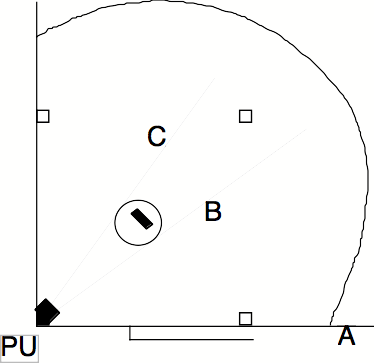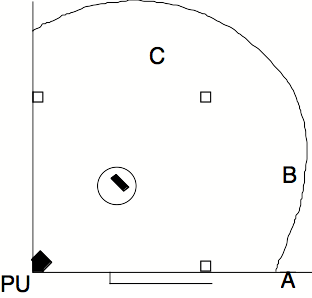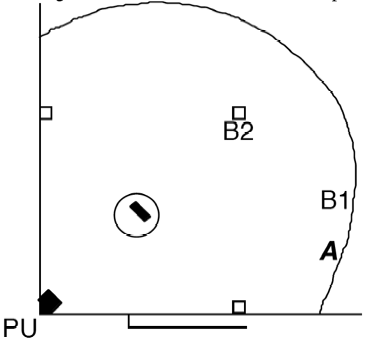Large Field Positions
|
Introduction |
The following are the three positions for the base umpire working on a large baseball diamond with 90’ base paths. |
|

|
"A" Position |
With bases empty, the base umpire will be in the “A” position:
• About 15 feet behind 1st base or 2 feet behind the first baseman, whichever is farther,
• Both feet in foul territory with the right foot next to the foul line, and
• Shoulders are square to the plate.
From the “A” position the base umpire will:
• Make the safe/out calls at first;
• Be responsible for fair/foul calls from the bag and beyond;
• Cover trouble fly balls in right and right-center field;
• If the batter-runner gets a base hit that goes through the infield the base umpire will take the batter-runner around the bases watching the batter-runner touch bases and make any calls at the bases.
|
"B" Position |
The base umpire will be in the “B” position:
• With a runner on 1st only,
• With runners on 2nd and 3rd, or
• With a runner on 3rd,
or
• Bases loaded.
The “B” position is:
• Straddle an imaginary line from the point of home plate extending out through the cut of the pitcher’s mound on the 1st base side,
• With a runner on first base: about half way between the pitcher’s plate and 2nd base, or
• With first base empty: back about two-thirds between the pitcher’s plate and 2nd base, and
• Shoulders are square to the plate.
|
"C" Position |
The base umpire will be in the “C” Position:
• With a runner on second base and third base open, or
• With runners on second and/or third with a left handed batter up.
The “C” Position is:
• Straddle an imaginary line from the point of home plate extending out through the cut of the pitcher’s mound on the 3rd base side,
• Back about two-thirds between the pitcher’s plate and 2nd base, and
• Shoulders are square to the plate.
|
| Inside Responsibilities
|
When working in the “B” or “C” positions the base umpire will:
• Be responsible for any pick off plays at any of the bases;
• Balks;
• Make calls on the bases unless the plate umpire is covering third base on certain situations;
• Be responsible for runners touching bases during a base hit and a runner touching second on fly balls.
• Be responsible for all fly balls unless the plate umpire calls you off.
|
Small Diamond Field Positions
Introduction |
The following are the three positions for the base umpire when working on a small diamond with 65’ base paths for fast-pitch softball or little league baseball. |
|

|
"A" Position |
With no one on base, the base umpire will be in the “A” position:
• About 15 feet behind 1st base or 2 feet behind the first baseman, whichever is farther,
• Both feet in foul territory with the right foot next to the foul line, and
• Shoulders are square to the plate.
From the “A” position the base umpire will:
• Watch for illegal pitches;
• Make the safe/out calls at first;
• Be responsible for fair/foul calls from the bag and beyond;
• If the batter-runner gets a base hit that goes through the infield the base umpire will take the batter-runner around the bases watching the batter-runner touch bases and make any calls at the bases.
|
| "B" Position
|
With a runner on 1st base only, the base umpire will be in the “B” position:
• About 15 feet behind the first-second baseline or 2 feet behind the second baseman, whichever is farther, and
• Half way between first and second,
• Shoulders are square to the runner on 1st base with peripheral vision on pitcher. Once pitcher releases the pitch look to home plate.
|
"C" Position |
In all other situations, the base umpire will be in the “C” position:
• About two feet behind the shortstop.
• Flex with the shortstop: If shortstop takes a position close to 2nd, be on the 3rd base side. If shortstop takes a position close to 3rd, be on the 2nd base side.
• Shoulders are square to home plate.
|
"B" and "C" Responsibilities |
When working in the “B” or “C” positions the base umpire will:
• Be responsible for any pick off plays at any of the bases;
• Illegal pitches;
• Make calls on the bases unless the plate umpire is covering third base on certain situations;
• Be responsible for runners touching bases during a base hit and fly balls.
Movement will depend on where the ball is hit.
• Batted balls that stay in the infield, stay outside and cover 1st and 2nd base. Plate umpire will cover 3rd base.
• Batter or thrown balls that leave the infield (go to the outfield) move inside to a position near the pitcher’s plate. This allows the base umpire to get angles on plays at the bases. As the play comes to that base move toward the play to make the call
|
Slow Pitch Field Positions
Introduction |
The following are the four positions for the base umpire when working on a small diamond with 65’ base paths. |
|

|
| "A" Position
|
With bases empty or a runner on 3rd base only the base umpire will be in the “A” position:
• About 15 feet behind the line between 1st and 2nd or 2 feet behind the first baseman, whichever is farther,
• Shoulders are square to the plate.
From the “A” position the base umpire will:
• Watch for illegal pitches;
• Make the safe/out calls at first;
• Be responsible for fair/foul calls from the bag and beyond;
• If the batter-runner gets a base hit that goes through the infield the base umpire will take the batter-runner around the bases watching the batter-runner touch bases and make any calls at the bases.
|
"B1" Position |
In all other situations the base umpire will be in the “B1” position:
• About 15 feet behind the first-second baseline or 2 feet behind the second baseman, whichever is farther, and
• Half way between first and second,
• Shoulders are square to the plate with peripheral vision on the runners.
|
| "B2" Position
|
The “B2” position is an advanced position and should only be used by umpires who are quick on their feet and know and understand the game.
This position allows the base umpire to get inside immediately when the ball is put in play. You must be able to move quickly and get out of the way, but the inside position allows the base umpire to get better angle on plays at the bases.
With a runner on 1st and/or 2nd base the base umpire will be in the “B2” position:
• Right next to 2nd base on the 1st base side, and
• Shoulders are square to the plate with peripheral vision on the runners.
|
| "B" Responsibilities
|
When working in either “B” position the base umpire will:
• Make calls on the bases unless the plate umpire is covering third base on certain situations;
• Be responsible for runners touching bases during a base hit and fly balls.
Movement will depend on where the ball is hit.
• Batted balls that stay in the infield, stay outside and cover 1st and 2nd base. Plate umpire will cover 3rd base.
• Batter or thrown balls that leave the infield (go to the outfield) move inside to a position near the pitcher’s plate. This allows the base umpire to get angles on plays at the bases. As the play comes to that base move toward the play to make the call.
|
Top | Large Field Positions | Small Field Positions | Slow Pitch Field Positions |
